Stakeholder Engagement Plan for Sydney Airport Parallel Runway
VerifiedAdded on 2023/06/06
|25
|5745
|259
Report
AI Summary
This report presents a comprehensive stakeholder engagement plan for the Sydney Airport Parallel Runway project, which aims to expand the airport's capacity. The plan outlines the project's purpose, scope, and influence area, defining three zones of stakeholders based on their level of interaction with the project. It details the objectives of the plan, including improving decision-making, fostering communication, and building relationships between the project management team and the community and government. The plan emphasizes adherence to national and international regulations, provides an overview of stakeholder engagement principles, and addresses potential concerns such as developing trust, managing expectations, and overcoming stakeholder fatigue. The methodology includes stakeholder analysis to identify appropriate consultation methods and engagement frequency, and the report further defines project stakeholders, engagement activities, resources, responsibilities, engagement tools, and monitoring, evaluation, and reporting mechanisms.

Stakeholders Planning 1
STAKEHOLDER ENGAGEMENT PLAN FOR SYDNEY AIRPORT PARALLEL RUNWAY
PROJECT
Name
Institution
Course
Tutor
Date
STAKEHOLDER ENGAGEMENT PLAN FOR SYDNEY AIRPORT PARALLEL RUNWAY
PROJECT
Name
Institution
Course
Tutor
Date
Paraphrase This Document
Need a fresh take? Get an instant paraphrase of this document with our AI Paraphraser
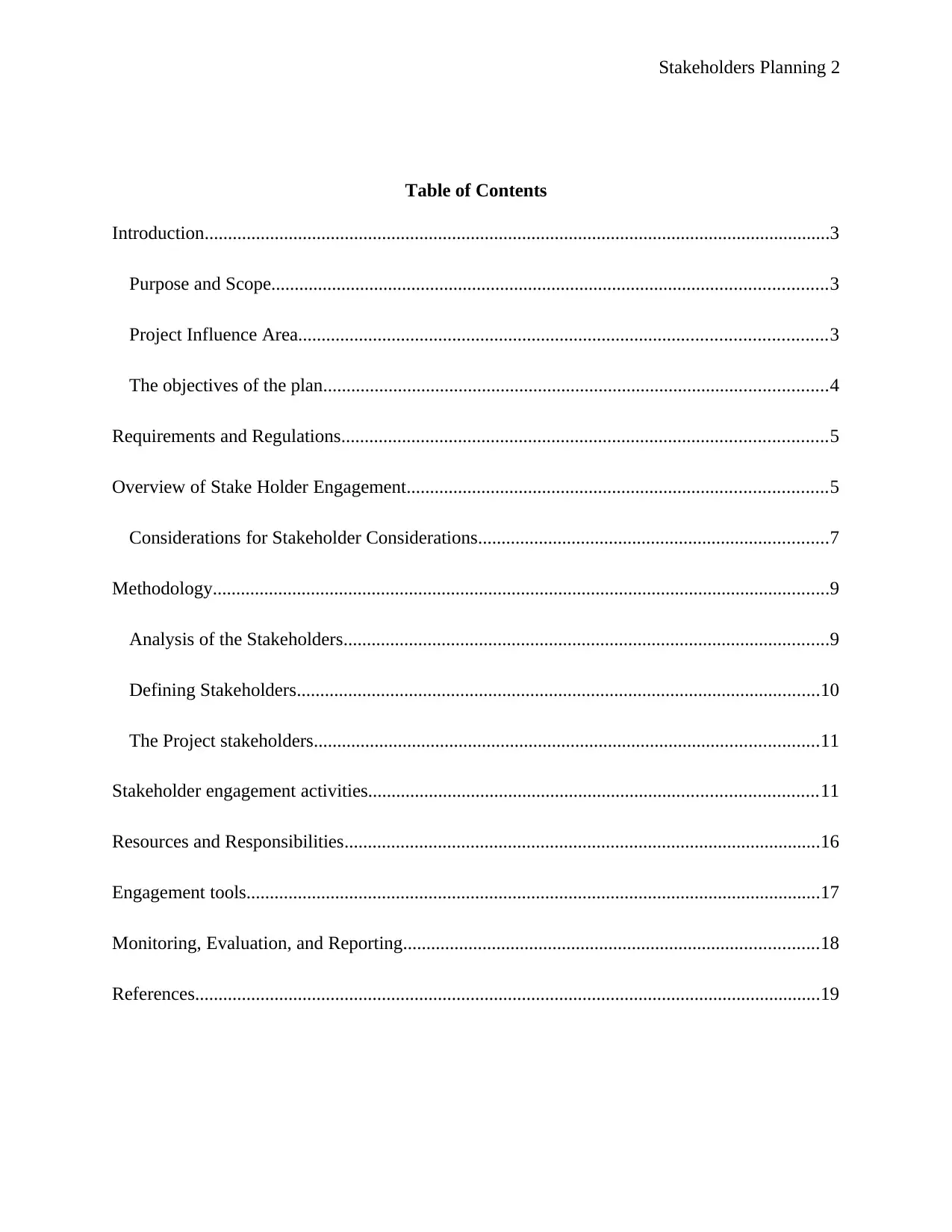
Stakeholders Planning 2
Table of Contents
Introduction......................................................................................................................................3
Purpose and Scope.......................................................................................................................3
Project Influence Area.................................................................................................................3
The objectives of the plan............................................................................................................4
Requirements and Regulations........................................................................................................5
Overview of Stake Holder Engagement..........................................................................................5
Considerations for Stakeholder Considerations...........................................................................7
Methodology....................................................................................................................................9
Analysis of the Stakeholders........................................................................................................9
Defining Stakeholders................................................................................................................10
The Project stakeholders............................................................................................................11
Stakeholder engagement activities................................................................................................11
Resources and Responsibilities......................................................................................................16
Engagement tools...........................................................................................................................17
Monitoring, Evaluation, and Reporting.........................................................................................18
References......................................................................................................................................19
Table of Contents
Introduction......................................................................................................................................3
Purpose and Scope.......................................................................................................................3
Project Influence Area.................................................................................................................3
The objectives of the plan............................................................................................................4
Requirements and Regulations........................................................................................................5
Overview of Stake Holder Engagement..........................................................................................5
Considerations for Stakeholder Considerations...........................................................................7
Methodology....................................................................................................................................9
Analysis of the Stakeholders........................................................................................................9
Defining Stakeholders................................................................................................................10
The Project stakeholders............................................................................................................11
Stakeholder engagement activities................................................................................................11
Resources and Responsibilities......................................................................................................16
Engagement tools...........................................................................................................................17
Monitoring, Evaluation, and Reporting.........................................................................................18
References......................................................................................................................................19
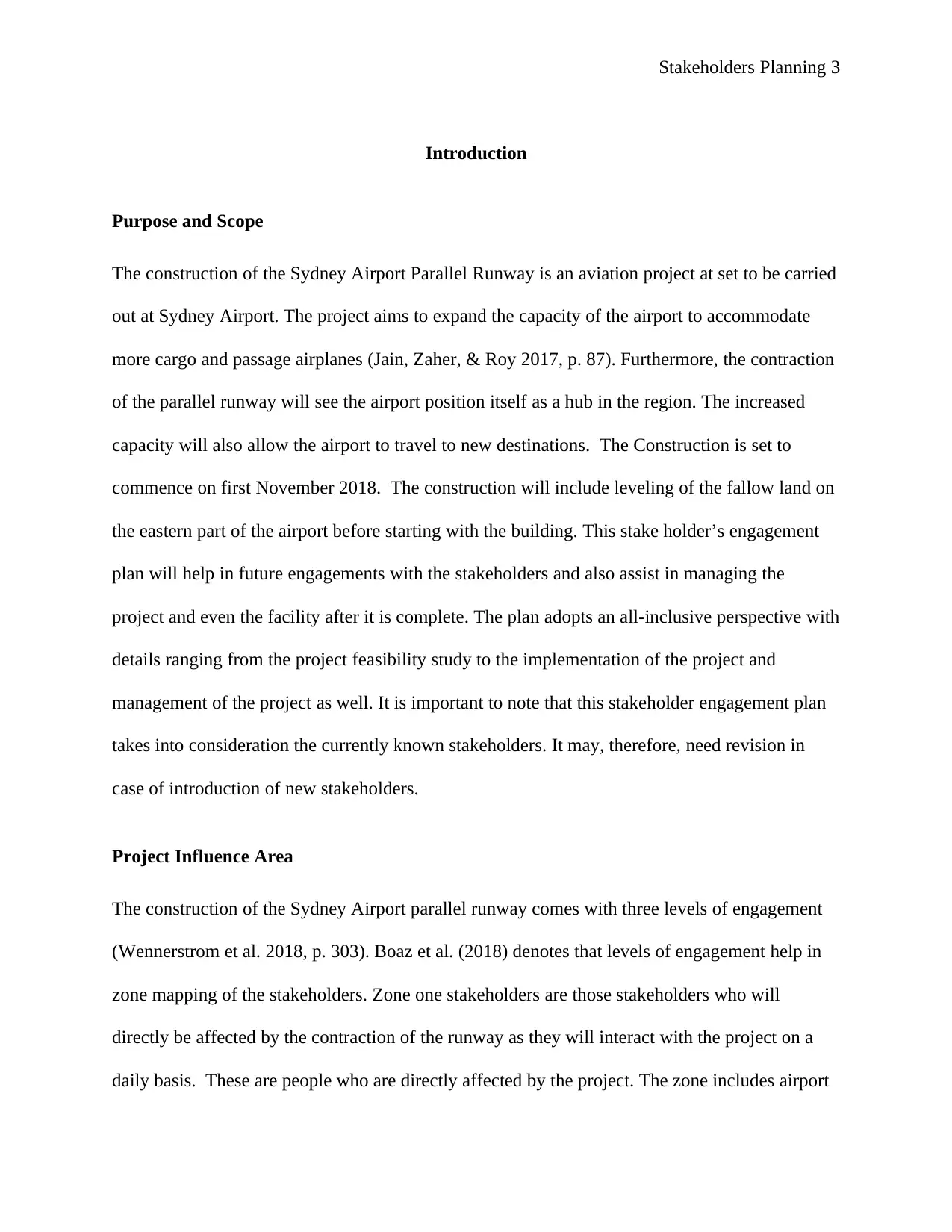
Stakeholders Planning 3
Introduction
Purpose and Scope
The construction of the Sydney Airport Parallel Runway is an aviation project at set to be carried
out at Sydney Airport. The project aims to expand the capacity of the airport to accommodate
more cargo and passage airplanes (Jain, Zaher, & Roy 2017, p. 87). Furthermore, the contraction
of the parallel runway will see the airport position itself as a hub in the region. The increased
capacity will also allow the airport to travel to new destinations. The Construction is set to
commence on first November 2018. The construction will include leveling of the fallow land on
the eastern part of the airport before starting with the building. This stake holder’s engagement
plan will help in future engagements with the stakeholders and also assist in managing the
project and even the facility after it is complete. The plan adopts an all-inclusive perspective with
details ranging from the project feasibility study to the implementation of the project and
management of the project as well. It is important to note that this stakeholder engagement plan
takes into consideration the currently known stakeholders. It may, therefore, need revision in
case of introduction of new stakeholders.
Project Influence Area
The construction of the Sydney Airport parallel runway comes with three levels of engagement
(Wennerstrom et al. 2018, p. 303). Boaz et al. (2018) denotes that levels of engagement help in
zone mapping of the stakeholders. Zone one stakeholders are those stakeholders who will
directly be affected by the contraction of the runway as they will interact with the project on a
daily basis. These are people who are directly affected by the project. The zone includes airport
Introduction
Purpose and Scope
The construction of the Sydney Airport Parallel Runway is an aviation project at set to be carried
out at Sydney Airport. The project aims to expand the capacity of the airport to accommodate
more cargo and passage airplanes (Jain, Zaher, & Roy 2017, p. 87). Furthermore, the contraction
of the parallel runway will see the airport position itself as a hub in the region. The increased
capacity will also allow the airport to travel to new destinations. The Construction is set to
commence on first November 2018. The construction will include leveling of the fallow land on
the eastern part of the airport before starting with the building. This stake holder’s engagement
plan will help in future engagements with the stakeholders and also assist in managing the
project and even the facility after it is complete. The plan adopts an all-inclusive perspective with
details ranging from the project feasibility study to the implementation of the project and
management of the project as well. It is important to note that this stakeholder engagement plan
takes into consideration the currently known stakeholders. It may, therefore, need revision in
case of introduction of new stakeholders.
Project Influence Area
The construction of the Sydney Airport parallel runway comes with three levels of engagement
(Wennerstrom et al. 2018, p. 303). Boaz et al. (2018) denotes that levels of engagement help in
zone mapping of the stakeholders. Zone one stakeholders are those stakeholders who will
directly be affected by the contraction of the runway as they will interact with the project on a
daily basis. These are people who are directly affected by the project. The zone includes airport
⊘ This is a preview!⊘
Do you want full access?
Subscribe today to unlock all pages.

Trusted by 1+ million students worldwide

Stakeholders Planning 4
workers, construction job seekers, regular airports customers and pilots. The zone two
stakeholders are those who will interact with the project but not as frequent as the zone one
stakeholder. This zone includes civil societies, religious bodies, academic institutions, and
research institutions (Dyer, Grey, & Siddall 2013). The zone three stakeholders who are the
minor stakeholders as their interaction with the project are expected to be limited. The minor
stakeholders include the representation from the city dwellers.
The objectives of the plan
The plan aims at improving decision making and understanding between the Sydney Airport
Parallel runway project management team and the community. It is intended to create a friendly
atmosphere to enable smooth operation with the support of both the city and the government.
Furthermore, the plan creates an adequate opportunity for the community and the government to
communicate any grievances promptly (Rodriguez-Melo & Mansouri 2018). Other than that, the
project management team is also provided with avenues for fair sharing of information and
making clarifications as well as giving responses on the issues raised by the community and the
government. The objectives are summarized as follows;
Find out the majors stakeholders who will be affected by the project and those who can
influence the activities of the project.
Find out the best channels of communication through which the project management can
disseminate information and ensure accessibility, transparency and adequate
consolations.
Aid in building mutual respect and long-lasting relationships between the stakeholders
and the project management for the benefit of both parties.
workers, construction job seekers, regular airports customers and pilots. The zone two
stakeholders are those who will interact with the project but not as frequent as the zone one
stakeholder. This zone includes civil societies, religious bodies, academic institutions, and
research institutions (Dyer, Grey, & Siddall 2013). The zone three stakeholders who are the
minor stakeholders as their interaction with the project are expected to be limited. The minor
stakeholders include the representation from the city dwellers.
The objectives of the plan
The plan aims at improving decision making and understanding between the Sydney Airport
Parallel runway project management team and the community. It is intended to create a friendly
atmosphere to enable smooth operation with the support of both the city and the government.
Furthermore, the plan creates an adequate opportunity for the community and the government to
communicate any grievances promptly (Rodriguez-Melo & Mansouri 2018). Other than that, the
project management team is also provided with avenues for fair sharing of information and
making clarifications as well as giving responses on the issues raised by the community and the
government. The objectives are summarized as follows;
Find out the majors stakeholders who will be affected by the project and those who can
influence the activities of the project.
Find out the best channels of communication through which the project management can
disseminate information and ensure accessibility, transparency and adequate
consolations.
Aid in building mutual respect and long-lasting relationships between the stakeholders
and the project management for the benefit of both parties.
Paraphrase This Document
Need a fresh take? Get an instant paraphrase of this document with our AI Paraphraser
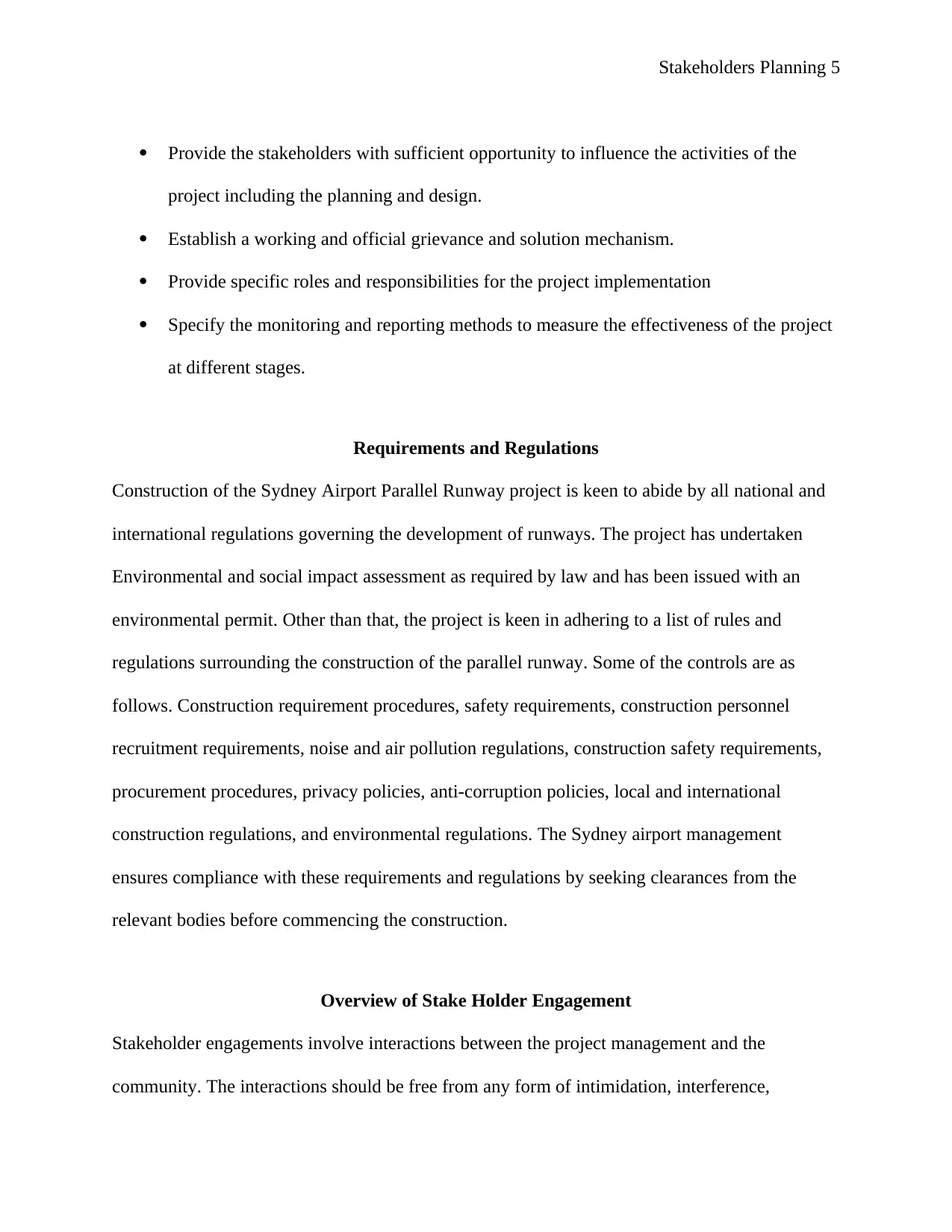
Stakeholders Planning 5
Provide the stakeholders with sufficient opportunity to influence the activities of the
project including the planning and design.
Establish a working and official grievance and solution mechanism.
Provide specific roles and responsibilities for the project implementation
Specify the monitoring and reporting methods to measure the effectiveness of the project
at different stages.
Requirements and Regulations
Construction of the Sydney Airport Parallel Runway project is keen to abide by all national and
international regulations governing the development of runways. The project has undertaken
Environmental and social impact assessment as required by law and has been issued with an
environmental permit. Other than that, the project is keen in adhering to a list of rules and
regulations surrounding the construction of the parallel runway. Some of the controls are as
follows. Construction requirement procedures, safety requirements, construction personnel
recruitment requirements, noise and air pollution regulations, construction safety requirements,
procurement procedures, privacy policies, anti-corruption policies, local and international
construction regulations, and environmental regulations. The Sydney airport management
ensures compliance with these requirements and regulations by seeking clearances from the
relevant bodies before commencing the construction.
Overview of Stake Holder Engagement
Stakeholder engagements involve interactions between the project management and the
community. The interactions should be free from any form of intimidation, interference,
Provide the stakeholders with sufficient opportunity to influence the activities of the
project including the planning and design.
Establish a working and official grievance and solution mechanism.
Provide specific roles and responsibilities for the project implementation
Specify the monitoring and reporting methods to measure the effectiveness of the project
at different stages.
Requirements and Regulations
Construction of the Sydney Airport Parallel Runway project is keen to abide by all national and
international regulations governing the development of runways. The project has undertaken
Environmental and social impact assessment as required by law and has been issued with an
environmental permit. Other than that, the project is keen in adhering to a list of rules and
regulations surrounding the construction of the parallel runway. Some of the controls are as
follows. Construction requirement procedures, safety requirements, construction personnel
recruitment requirements, noise and air pollution regulations, construction safety requirements,
procurement procedures, privacy policies, anti-corruption policies, local and international
construction regulations, and environmental regulations. The Sydney airport management
ensures compliance with these requirements and regulations by seeking clearances from the
relevant bodies before commencing the construction.
Overview of Stake Holder Engagement
Stakeholder engagements involve interactions between the project management and the
community. The interactions should be free from any form of intimidation, interference,
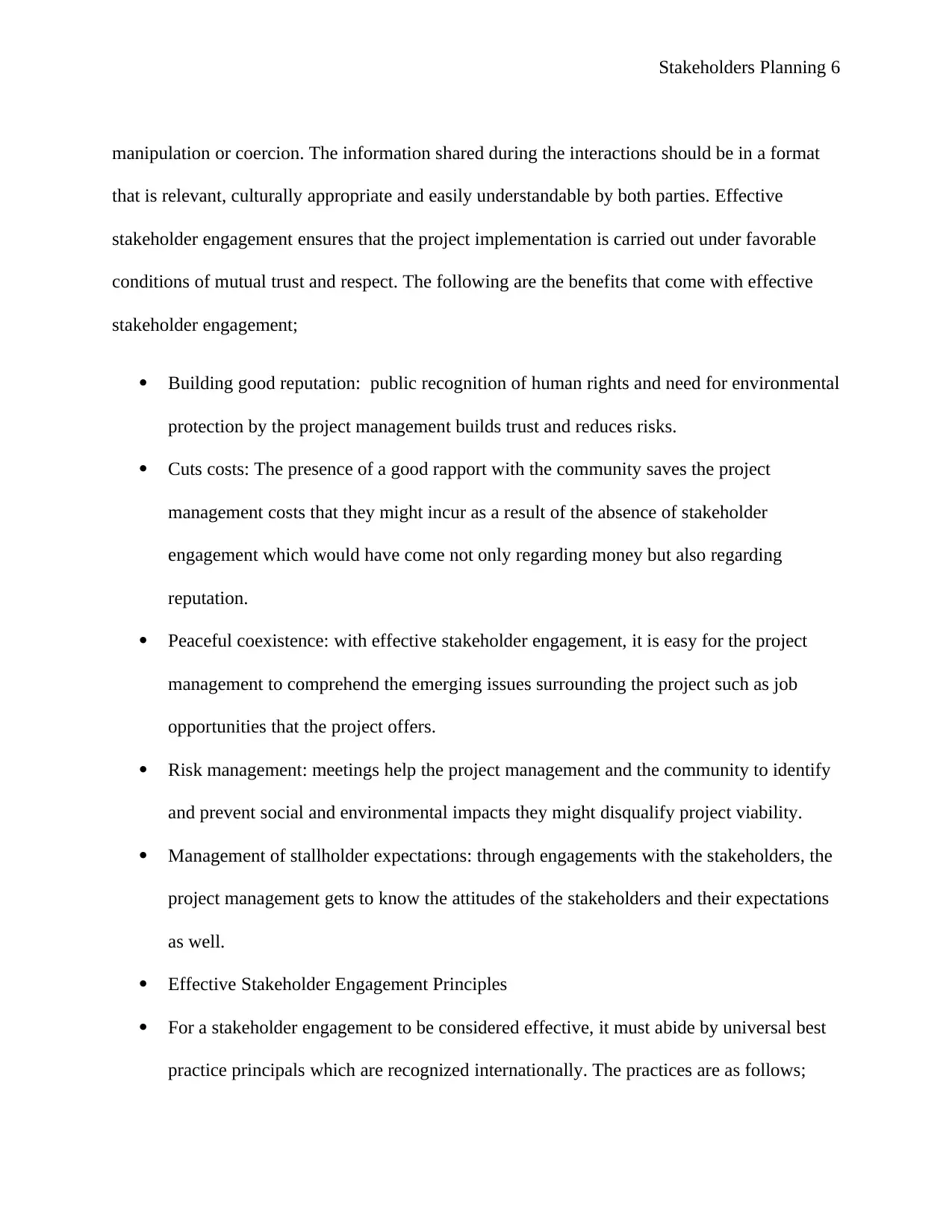
Stakeholders Planning 6
manipulation or coercion. The information shared during the interactions should be in a format
that is relevant, culturally appropriate and easily understandable by both parties. Effective
stakeholder engagement ensures that the project implementation is carried out under favorable
conditions of mutual trust and respect. The following are the benefits that come with effective
stakeholder engagement;
Building good reputation: public recognition of human rights and need for environmental
protection by the project management builds trust and reduces risks.
Cuts costs: The presence of a good rapport with the community saves the project
management costs that they might incur as a result of the absence of stakeholder
engagement which would have come not only regarding money but also regarding
reputation.
Peaceful coexistence: with effective stakeholder engagement, it is easy for the project
management to comprehend the emerging issues surrounding the project such as job
opportunities that the project offers.
Risk management: meetings help the project management and the community to identify
and prevent social and environmental impacts they might disqualify project viability.
Management of stallholder expectations: through engagements with the stakeholders, the
project management gets to know the attitudes of the stakeholders and their expectations
as well.
Effective Stakeholder Engagement Principles
For a stakeholder engagement to be considered effective, it must abide by universal best
practice principals which are recognized internationally. The practices are as follows;
manipulation or coercion. The information shared during the interactions should be in a format
that is relevant, culturally appropriate and easily understandable by both parties. Effective
stakeholder engagement ensures that the project implementation is carried out under favorable
conditions of mutual trust and respect. The following are the benefits that come with effective
stakeholder engagement;
Building good reputation: public recognition of human rights and need for environmental
protection by the project management builds trust and reduces risks.
Cuts costs: The presence of a good rapport with the community saves the project
management costs that they might incur as a result of the absence of stakeholder
engagement which would have come not only regarding money but also regarding
reputation.
Peaceful coexistence: with effective stakeholder engagement, it is easy for the project
management to comprehend the emerging issues surrounding the project such as job
opportunities that the project offers.
Risk management: meetings help the project management and the community to identify
and prevent social and environmental impacts they might disqualify project viability.
Management of stallholder expectations: through engagements with the stakeholders, the
project management gets to know the attitudes of the stakeholders and their expectations
as well.
Effective Stakeholder Engagement Principles
For a stakeholder engagement to be considered effective, it must abide by universal best
practice principals which are recognized internationally. The practices are as follows;
⊘ This is a preview!⊘
Do you want full access?
Subscribe today to unlock all pages.

Trusted by 1+ million students worldwide
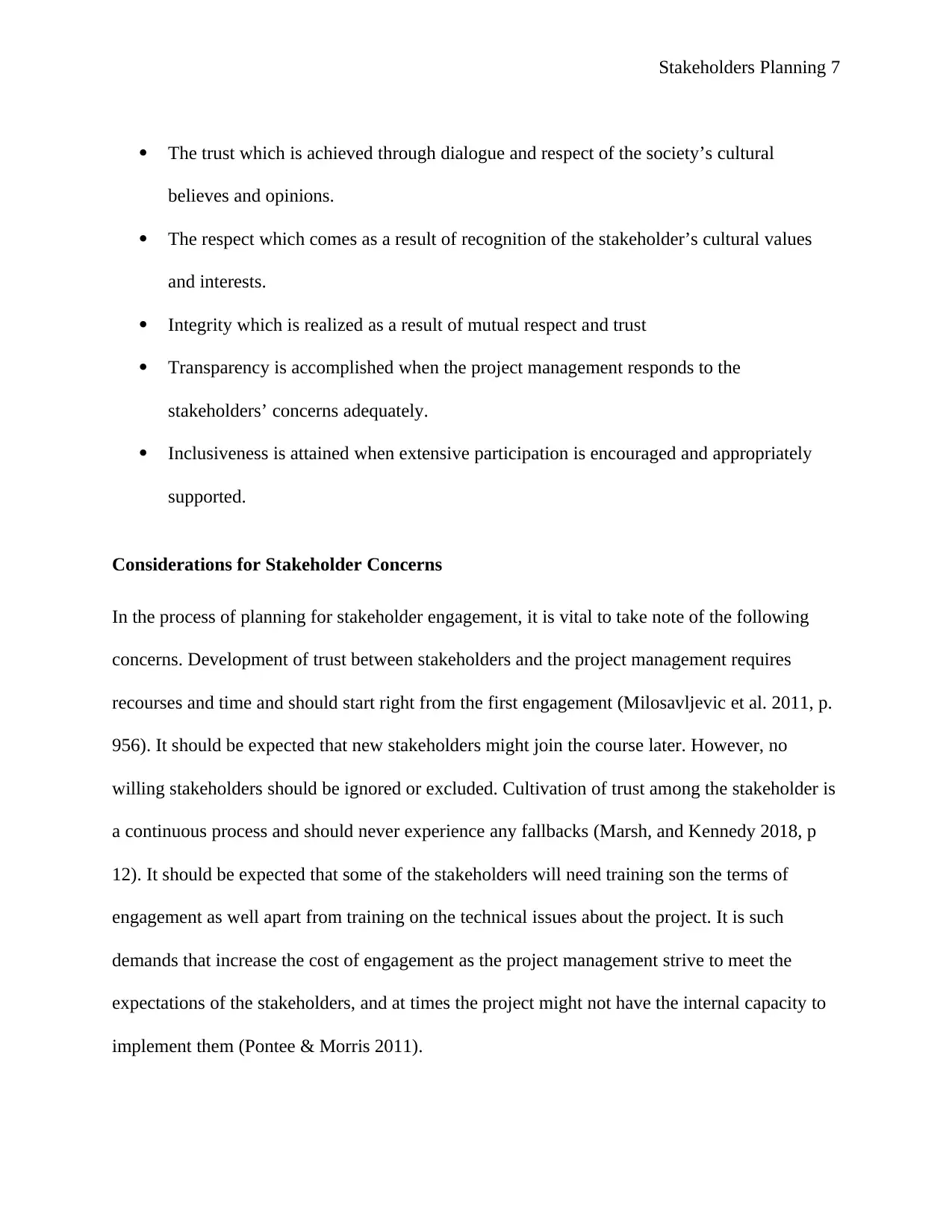
Stakeholders Planning 7
The trust which is achieved through dialogue and respect of the society’s cultural
believes and opinions.
The respect which comes as a result of recognition of the stakeholder’s cultural values
and interests.
Integrity which is realized as a result of mutual respect and trust
Transparency is accomplished when the project management responds to the
stakeholders’ concerns adequately.
Inclusiveness is attained when extensive participation is encouraged and appropriately
supported.
Considerations for Stakeholder Concerns
In the process of planning for stakeholder engagement, it is vital to take note of the following
concerns. Development of trust between stakeholders and the project management requires
recourses and time and should start right from the first engagement (Milosavljevic et al. 2011, p.
956). It should be expected that new stakeholders might join the course later. However, no
willing stakeholders should be ignored or excluded. Cultivation of trust among the stakeholder is
a continuous process and should never experience any fallbacks (Marsh, and Kennedy 2018, p
12). It should be expected that some of the stakeholders will need training son the terms of
engagement as well apart from training on the technical issues about the project. It is such
demands that increase the cost of engagement as the project management strive to meet the
expectations of the stakeholders, and at times the project might not have the internal capacity to
implement them (Pontee & Morris 2011).
The trust which is achieved through dialogue and respect of the society’s cultural
believes and opinions.
The respect which comes as a result of recognition of the stakeholder’s cultural values
and interests.
Integrity which is realized as a result of mutual respect and trust
Transparency is accomplished when the project management responds to the
stakeholders’ concerns adequately.
Inclusiveness is attained when extensive participation is encouraged and appropriately
supported.
Considerations for Stakeholder Concerns
In the process of planning for stakeholder engagement, it is vital to take note of the following
concerns. Development of trust between stakeholders and the project management requires
recourses and time and should start right from the first engagement (Milosavljevic et al. 2011, p.
956). It should be expected that new stakeholders might join the course later. However, no
willing stakeholders should be ignored or excluded. Cultivation of trust among the stakeholder is
a continuous process and should never experience any fallbacks (Marsh, and Kennedy 2018, p
12). It should be expected that some of the stakeholders will need training son the terms of
engagement as well apart from training on the technical issues about the project. It is such
demands that increase the cost of engagement as the project management strive to meet the
expectations of the stakeholders, and at times the project might not have the internal capacity to
implement them (Pontee & Morris 2011).
Paraphrase This Document
Need a fresh take? Get an instant paraphrase of this document with our AI Paraphraser
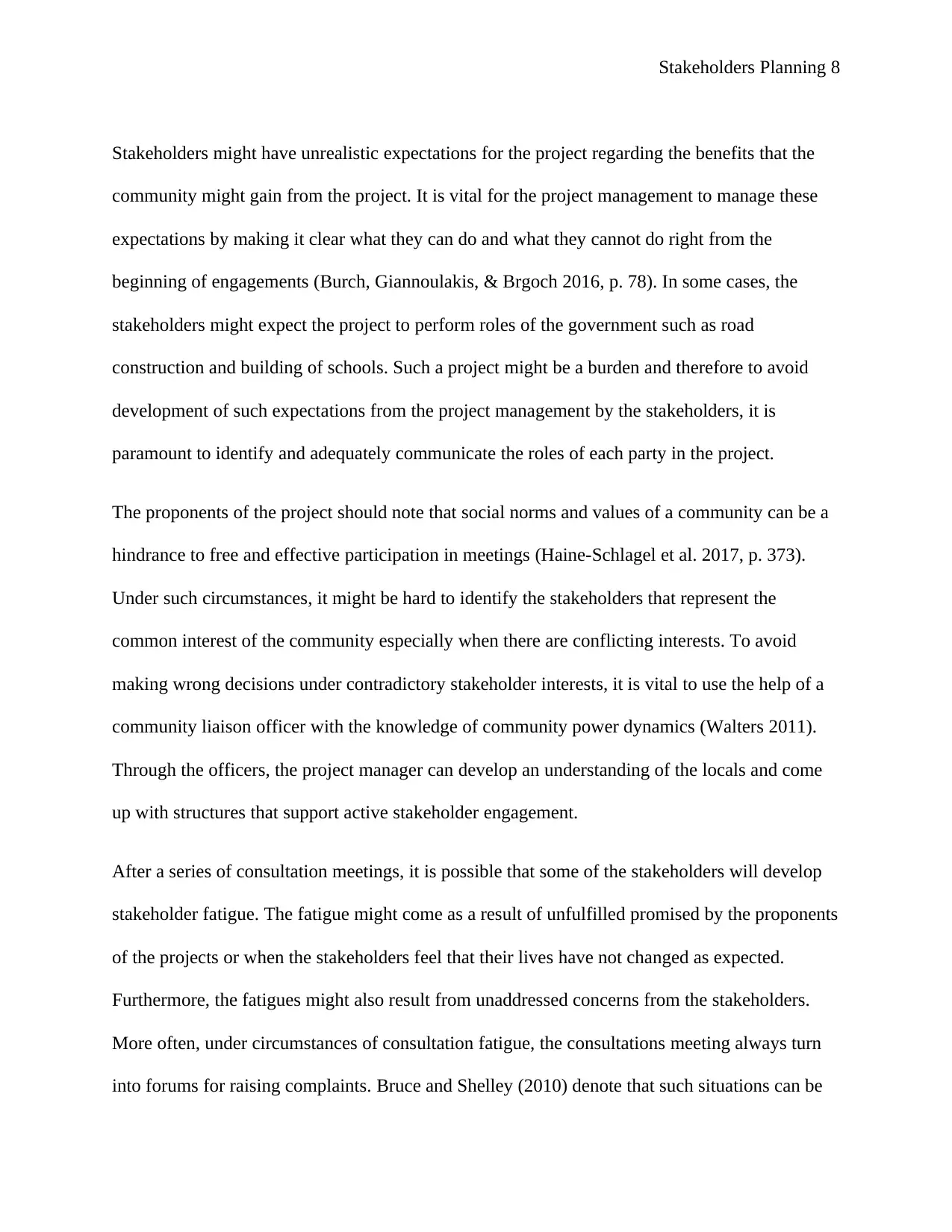
Stakeholders Planning 8
Stakeholders might have unrealistic expectations for the project regarding the benefits that the
community might gain from the project. It is vital for the project management to manage these
expectations by making it clear what they can do and what they cannot do right from the
beginning of engagements (Burch, Giannoulakis, & Brgoch 2016, p. 78). In some cases, the
stakeholders might expect the project to perform roles of the government such as road
construction and building of schools. Such a project might be a burden and therefore to avoid
development of such expectations from the project management by the stakeholders, it is
paramount to identify and adequately communicate the roles of each party in the project.
The proponents of the project should note that social norms and values of a community can be a
hindrance to free and effective participation in meetings (Haine-Schlagel et al. 2017, p. 373).
Under such circumstances, it might be hard to identify the stakeholders that represent the
common interest of the community especially when there are conflicting interests. To avoid
making wrong decisions under contradictory stakeholder interests, it is vital to use the help of a
community liaison officer with the knowledge of community power dynamics (Walters 2011).
Through the officers, the project manager can develop an understanding of the locals and come
up with structures that support active stakeholder engagement.
After a series of consultation meetings, it is possible that some of the stakeholders will develop
stakeholder fatigue. The fatigue might come as a result of unfulfilled promised by the proponents
of the projects or when the stakeholders feel that their lives have not changed as expected.
Furthermore, the fatigues might also result from unaddressed concerns from the stakeholders.
More often, under circumstances of consultation fatigue, the consultations meeting always turn
into forums for raising complaints. Bruce and Shelley (2010) denote that such situations can be
Stakeholders might have unrealistic expectations for the project regarding the benefits that the
community might gain from the project. It is vital for the project management to manage these
expectations by making it clear what they can do and what they cannot do right from the
beginning of engagements (Burch, Giannoulakis, & Brgoch 2016, p. 78). In some cases, the
stakeholders might expect the project to perform roles of the government such as road
construction and building of schools. Such a project might be a burden and therefore to avoid
development of such expectations from the project management by the stakeholders, it is
paramount to identify and adequately communicate the roles of each party in the project.
The proponents of the project should note that social norms and values of a community can be a
hindrance to free and effective participation in meetings (Haine-Schlagel et al. 2017, p. 373).
Under such circumstances, it might be hard to identify the stakeholders that represent the
common interest of the community especially when there are conflicting interests. To avoid
making wrong decisions under contradictory stakeholder interests, it is vital to use the help of a
community liaison officer with the knowledge of community power dynamics (Walters 2011).
Through the officers, the project manager can develop an understanding of the locals and come
up with structures that support active stakeholder engagement.
After a series of consultation meetings, it is possible that some of the stakeholders will develop
stakeholder fatigue. The fatigue might come as a result of unfulfilled promised by the proponents
of the projects or when the stakeholders feel that their lives have not changed as expected.
Furthermore, the fatigues might also result from unaddressed concerns from the stakeholders.
More often, under circumstances of consultation fatigue, the consultations meeting always turn
into forums for raising complaints. Bruce and Shelley (2010) denote that such situations can be

Stakeholders Planning 9
prevented by ensuring that stakeholder meetings are not used to give promised but to manage the
expectations of the stakeholders and disseminate vital project information. Furthermore, the
forums should be used to get feedback and views from the stakeholders and project specialists.
The rest of this stakeholder engagement plan focuses on strategies for overcoming the concerns
mentioned above to ensure smooth implementation of the Sydney Airports Parallel runway
project.
Methodology
Analysis of the Stakeholders
The study of the stakeholders is essential in establishing a relationship between the project
management and the stakeholders (Marsh & Kennedy 2012, p. 89). It also aids in the
identification of suitable methods of consultations during the project. The most commonly used
consultation methods include radio broadcasts, newspapers, magazines, meetings, newsletters,
pamphlets, workshops, interviews, phone and emails. To help in the identification of the
appropriate frequency of engagement with a particular stakeholder group, Chirozva, Mukamuri,
and Manjengwa (2013) denote that some criteria need to be taken into consideration. First, the
project manager should look at the extent of the impact that the project has on the stakeholders'
group. Secondly, it is paramount to consider the influence that the stakeholder group has on the
project. Lastly, the project manager should look into the socially acceptable means of
engagement and passing information within the locality.
prevented by ensuring that stakeholder meetings are not used to give promised but to manage the
expectations of the stakeholders and disseminate vital project information. Furthermore, the
forums should be used to get feedback and views from the stakeholders and project specialists.
The rest of this stakeholder engagement plan focuses on strategies for overcoming the concerns
mentioned above to ensure smooth implementation of the Sydney Airports Parallel runway
project.
Methodology
Analysis of the Stakeholders
The study of the stakeholders is essential in establishing a relationship between the project
management and the stakeholders (Marsh & Kennedy 2012, p. 89). It also aids in the
identification of suitable methods of consultations during the project. The most commonly used
consultation methods include radio broadcasts, newspapers, magazines, meetings, newsletters,
pamphlets, workshops, interviews, phone and emails. To help in the identification of the
appropriate frequency of engagement with a particular stakeholder group, Chirozva, Mukamuri,
and Manjengwa (2013) denote that some criteria need to be taken into consideration. First, the
project manager should look at the extent of the impact that the project has on the stakeholders'
group. Secondly, it is paramount to consider the influence that the stakeholder group has on the
project. Lastly, the project manager should look into the socially acceptable means of
engagement and passing information within the locality.
⊘ This is a preview!⊘
Do you want full access?
Subscribe today to unlock all pages.

Trusted by 1+ million students worldwide
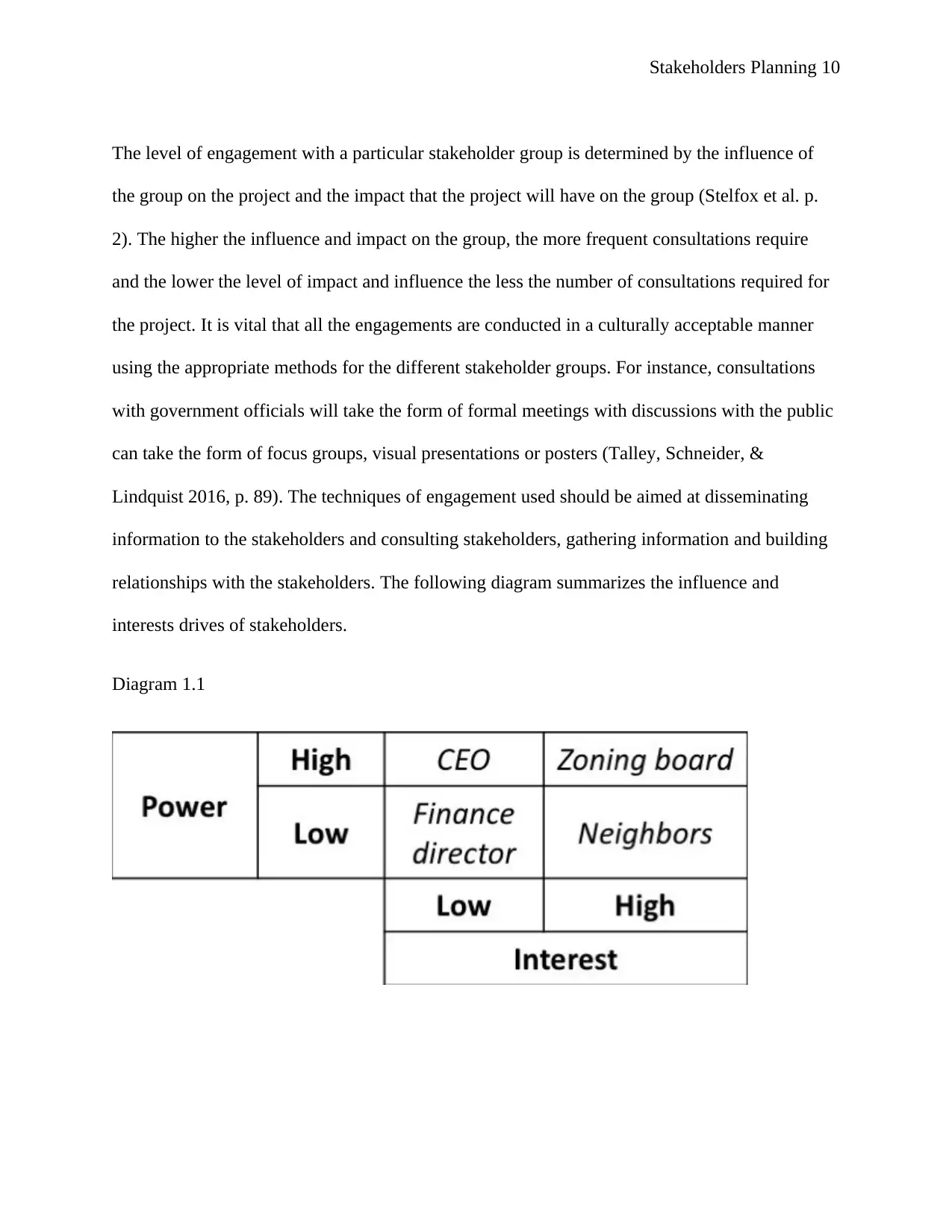
Stakeholders Planning 10
The level of engagement with a particular stakeholder group is determined by the influence of
the group on the project and the impact that the project will have on the group (Stelfox et al. p.
2). The higher the influence and impact on the group, the more frequent consultations require
and the lower the level of impact and influence the less the number of consultations required for
the project. It is vital that all the engagements are conducted in a culturally acceptable manner
using the appropriate methods for the different stakeholder groups. For instance, consultations
with government officials will take the form of formal meetings with discussions with the public
can take the form of focus groups, visual presentations or posters (Talley, Schneider, &
Lindquist 2016, p. 89). The techniques of engagement used should be aimed at disseminating
information to the stakeholders and consulting stakeholders, gathering information and building
relationships with the stakeholders. The following diagram summarizes the influence and
interests drives of stakeholders.
Diagram 1.1
The level of engagement with a particular stakeholder group is determined by the influence of
the group on the project and the impact that the project will have on the group (Stelfox et al. p.
2). The higher the influence and impact on the group, the more frequent consultations require
and the lower the level of impact and influence the less the number of consultations required for
the project. It is vital that all the engagements are conducted in a culturally acceptable manner
using the appropriate methods for the different stakeholder groups. For instance, consultations
with government officials will take the form of formal meetings with discussions with the public
can take the form of focus groups, visual presentations or posters (Talley, Schneider, &
Lindquist 2016, p. 89). The techniques of engagement used should be aimed at disseminating
information to the stakeholders and consulting stakeholders, gathering information and building
relationships with the stakeholders. The following diagram summarizes the influence and
interests drives of stakeholders.
Diagram 1.1
Paraphrase This Document
Need a fresh take? Get an instant paraphrase of this document with our AI Paraphraser

Stakeholders Planning 11
Defining Stakeholders
The stakeholders for Sydney Airport Parallel Runway Project will be categorized into three
groups. The first group will include the Government bodies such as government departments,
local authorities, and public advisory entities. The second category will consist of the immediate
community that will be affected by the projects. This category encompasses people seeking jobs
in the construction site, Representatives of the city dwellers and the airport workers. The third
category will take care of the civil societies as well as the development agencies such as religious
organizations, non-governmental organizations, academic and research institutes that work in the
line of aviation. The fourth and the last category will be that of commercial organizations. In this
category, local businesses, Unions and associations will be included. The local service and
product providers will also be included in this category (Bzdak 2015). Each of the classes has
groups and people with similar interests in the projects. This categorization will help in the
development of a working approach to be used during the stakeholder meetings. It is important
to note that the different stakeholders will be affected differently by the project and therefore
each category will require special attention during the stakeholder meetings. The plan takes into
consideration the key factors of interest and influences levels of the stake holder.
The Project stakeholders
In this section, gives close attention to the individual stallholders. The project stakeholder is:
Sidney Airport workers
Construction job seekers
Pilots
Defining Stakeholders
The stakeholders for Sydney Airport Parallel Runway Project will be categorized into three
groups. The first group will include the Government bodies such as government departments,
local authorities, and public advisory entities. The second category will consist of the immediate
community that will be affected by the projects. This category encompasses people seeking jobs
in the construction site, Representatives of the city dwellers and the airport workers. The third
category will take care of the civil societies as well as the development agencies such as religious
organizations, non-governmental organizations, academic and research institutes that work in the
line of aviation. The fourth and the last category will be that of commercial organizations. In this
category, local businesses, Unions and associations will be included. The local service and
product providers will also be included in this category (Bzdak 2015). Each of the classes has
groups and people with similar interests in the projects. This categorization will help in the
development of a working approach to be used during the stakeholder meetings. It is important
to note that the different stakeholders will be affected differently by the project and therefore
each category will require special attention during the stakeholder meetings. The plan takes into
consideration the key factors of interest and influences levels of the stake holder.
The Project stakeholders
In this section, gives close attention to the individual stallholders. The project stakeholder is:
Sidney Airport workers
Construction job seekers
Pilots

Stakeholders Planning 12
Regular customers
Local business people
Government department of infrastructure and regional development
Australian Building and construction commission
Australian Commission for safety and quality in healthcare
Civil aviation safety authority
Civil Society Australia
Residents of Sydney city center
Stakeholder engagement activities
Stakeholder activities on the Sydney Airport parallel runway project are vital for risk
management. It is therefore paramount to initiate the engagement as early as possible to avoid
potential negative impacts (Legacy 2011, p. 7). The stakeholder engagement is going to be
conducted in three phases. The first phase which will be the initial engagement phase will
involve interviews with representatives from the various stakeholder groups. The purpose of this
phase will be to:
Make the formal introduction of the project to the stakeholder representatives.
Identify and take note of issues and impacts that should be covered in the subsequent
phases of engagement.
Take note of how the stakeholders are related to the project
Acquire stakeholder opinions that should be fed into the assessment process.
Gather feedback on the precautions that the project has taken to mitigate the social-
environmental impact of the project.
Regular customers
Local business people
Government department of infrastructure and regional development
Australian Building and construction commission
Australian Commission for safety and quality in healthcare
Civil aviation safety authority
Civil Society Australia
Residents of Sydney city center
Stakeholder engagement activities
Stakeholder activities on the Sydney Airport parallel runway project are vital for risk
management. It is therefore paramount to initiate the engagement as early as possible to avoid
potential negative impacts (Legacy 2011, p. 7). The stakeholder engagement is going to be
conducted in three phases. The first phase which will be the initial engagement phase will
involve interviews with representatives from the various stakeholder groups. The purpose of this
phase will be to:
Make the formal introduction of the project to the stakeholder representatives.
Identify and take note of issues and impacts that should be covered in the subsequent
phases of engagement.
Take note of how the stakeholders are related to the project
Acquire stakeholder opinions that should be fed into the assessment process.
Gather feedback on the precautions that the project has taken to mitigate the social-
environmental impact of the project.
⊘ This is a preview!⊘
Do you want full access?
Subscribe today to unlock all pages.

Trusted by 1+ million students worldwide
1 out of 25
Related Documents
Your All-in-One AI-Powered Toolkit for Academic Success.
+13062052269
info@desklib.com
Available 24*7 on WhatsApp / Email
![[object Object]](/_next/static/media/star-bottom.7253800d.svg)
Unlock your academic potential
Copyright © 2020–2025 A2Z Services. All Rights Reserved. Developed and managed by ZUCOL.


